Art in the Travelling Landscape: Hi-Views
Summary of Hi-Views Final Report from December 2007
Background
Art & the Travelling Landscape is an art project focused on the National Cycle Network, a sustainable transport infrastructure with 12,000 miles of safe cycling and walking routes, linking the main cities, towns and villages across the UK. It is coordinated by Sustrans, a transport charity whose principal aims are to create conditions to walk and cycle in safety so people can choose to travel in ways that benefit their health and the environment.
Alongside the development of routes, Sustrans commissions site specific, environmental artworks to enhance the paths, to work with local people to explore and illuminate local characteristics, provide meeting and resting-places and create memorable and uplifting journeys. Art & the Travelling Landscape is an important aspect of the network and every effort is made to work with artists to develop sequential work that reflects the experience of travelling through a constantly changing landscape.
See details of Art & the Travelling Landscape commissions in the south west.
The Water Rail Way: Lincoln to Boston - National Cycle Network - route 1
The Water Rail Way is a long distance walking and cycling path that lies along parts of the former Lincoln to Boston railway line. The path runs alongside the River Witham and the large watercourse called Sincil Drain between Lincoln and Bardney. These water features dominate both the railway and access available to the future path. It supports a wide variety of flora and fauna, and particularly the Water Rail, a small bird whose special habitat is along the banks of the River Witham.
A feature of the path is the vast, open landscapes and the long-distance views. At the northern end Lincoln cathedral sits above the “Lincoln Gap”, the valley created from river erosion, and at the southern terminus St Botolph’s church, known as the “Stump” can be seen from many miles.
Development of Hi-Views
This project started in 2001 with a committed partnership between Lincolnshire Public Art Network [LPAN], and Sustrans’ staff at a local and national level. The path traverses six of the LPAN local authorities; Lincoln City, Boston Borough, North Kesteven, East Lindsey, West Lindsey, and Lincolnshire County Council They funded the selection and appointment of artist Martyn Barratt, to work on conceptual proposals for artworks along the route.
In response to the landscape Barrett produced a report ‘Time, Distance and Memory’ recommending a way of working and outlining opportunities where local people could be involved. The core proposal was the creation of a series of prospect towers to be spaced along the route between Lincoln Cathedral and Boston Stump. These towers would act as focus points where visitors could rise above the path and gain a different perspective on the surrounding area and long distance views. The report included working with a poet as well as the creation of gateways, resting-places and ‘interventions’ in the surface and fabric of the route itself.
Six of the partner authorities were already working together on local cycle routes as part of the environmental regeneration of the area. This included the development of this long distance walking and cycle path now called the Water Rail Way. Hence, with construction work at an early stage, the intention was that the process of commissioning artists would occur in parallel with the construction of the whole route.
Partnership
Once the main funding was in place, Sustrans set up a project steering group consisting of LPAN members and Arts Council England – East Midlands. The steering group advertised regionally for an experienced curator/coordinator to bring high quality artists/architects to work on the route. For Sustrans, this represented a new opportunity to work with architecture and an internationally renowned architect for the first time.
Appointment of a curator
Anna Douglas was appointed as Curator / Co-ordinator in 2003. She refocused and strengthened the initial project vision to take the audience to a physically different or higher place, nearer the sky, to give views of the landscape from a different perspective and angle. The intention was to commission a series of artist / architect / engineer designed towers, platforms, large scale structures, lookout points or elevated entrances, which focused on links between the inhabited and uninhabited landscape from where the traveller could gain another view of the landscape. They would create aerial views over the watery man-made moor-lands, and give close and long distance orientation of landmarks such as the Boston Stump and Lincoln Cathedral.
Artist selection
The curator undertook short listing for the creative team including the architect, artist and design company. She put together a selection group consisting of the key partners including Derek Cotterrell, Head of Architecture at Lincoln University, and Steven Palmer from Place Architects who agreed to assist as necessary with planning permissions etc from his UK base.
Paul Robbrecht from Robbrecht en Daem Architects was selected through an invited short list of architects from North Europe; this was to make a loose link with Lincoln’s Liveable Cities project.
The artwork
Lincoln Stump and Boston Pendulum: Paul Robbrecht
Robbrecht is renowned for his architectural collaborative work with artists, not only as an inventive creator himself but also in recent projects such as the Antwerp City Square where he worked with an artist and water engineers to create a vast ‘breathing’ bronze reed bed with water levels constantly changing.
The Hi-Views commission consisted of the design of two public ‘prospect’ viewing platforms which would afford the visitors the opportunity to gain height and views over the culturally distinctive landscape. Both viewing platforms are also places to rest during a journey.
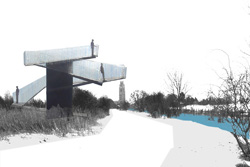
Initial Concept Design, Boston Pendulum by Paul Robbrecht
Image supplied by: Robbrecht en Daem
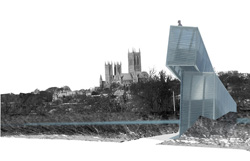
Initial Concept Design, Lincoln Stump Collage by Paul Robbrecht
Image supplied by: Robbrecht en Daem
Conversation Piece with Deborah Jones
Deborah spent several days on the path engaging people in conversation. As they conversed, she made notes and diagrams. She asked about their familiarity with the river and the path and any particular associations it has for them; asked them to describe its atmosphere and how it is at different times of the year; she inquired about social aspects of the place and discussed the emotional or mental impact walking has on people’s lives.
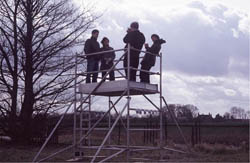
Conversation Piece with Deborah Jones
Photographer: Deborah Jones
Subsequently at two separate sites and as part of Architecture Week 2004 Deborah erected a temporary, 2.2m, aluminium tower with platform and railings alongside the river both at the intersection access point of two paths. With an assistant, she again engaged people in conversation – this time inviting them to come up onto the viewing platform.
Assessment
Impact of the structures
The structures were installed in September 2007. The winter months see less use of the path thus greater awareness and full use of the structures will occur in spring and summer 2008.
Hi-Views, the name and the physical staircases themselves set up an immediate tension with the flat landscape, stimulating a desire to mount the stairs and take time to see everyday things from a different perspective. The proportions, detailing and fabrication of the structures express care and attention for small things as well as to the whole. They have inspired the commissioning of additional artwork thoughtfully sited along the route, to compliment the landscape, sometimes referential and evocative concerning local myth, poetry and place. By 2008, when the full length of the Water Rail Way path opens the artworks will be an important element in the marketing and advertising of this long distance path.
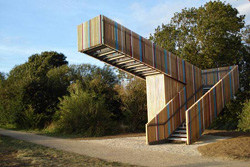
Boston Pendulum by Paul Robbrecht
Photographer: David Martin
Public impact
The towers have been sensitively designed by Robbrecht to relate to the unique Lincolnshire landscape and to incorporate the designs of the ‘crazy’ gothic vaulting in Lincoln Cathedral and the hollow tower of the Stump in Boston, and yet, they are uncompromisingly contemporary, thus illustrating the opportunities and relevance of contemporary design within such heritage contexts. The latter is a particular challenge for the outlying regions of the UK, where suspicion of contemporary design, architecture and art is higher than urban contexts, and contemporary architecture fights to get planning permission.

Lincoln Stump by Paul Robbrecht
Photographer: David Martin
The integrated community participatory programme created opportunities for local people and path users to meet with the artist/architect. It encouraged people to record personal feelings about their landscape. This enabled first hand contact and interaction between the public the architect and artists. Since the structures have been installed many people have stopped to talk about them and hundreds of people have delighted in using them. The designs are distinctively non-English, and have triggered discussions and further comments about design particularly in the light of so much urban development taking place currently across the UK.
The full report and appendices
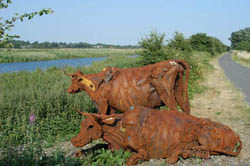
Lincolnshire Reds by Sally Matthews, near Stixwould
Water Rail Way, National Cycle Network, Route 1, Lincolnshire
Photographer: Sustrans
The brief report above is a summary of two longer documents:
Download the full report as an Adobe Acrobat format document, 2.882MB
Download the report appendices as an Adobe Acrobat format document, 3.955MB
Contacts for further information
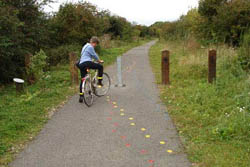
Paw Prints by Nicola Jones; Photographer: Sustrans
Water Rail Way National Cycle Network Route 1
Between Bardney and Woodhall Spa
Katy Hallett, Director, Art & the Travelling Landscape Sustrans
